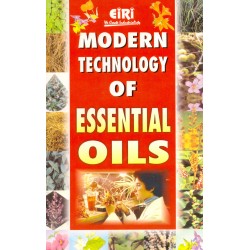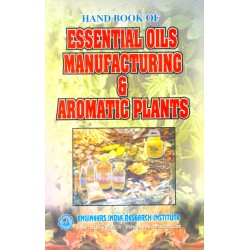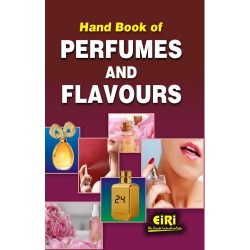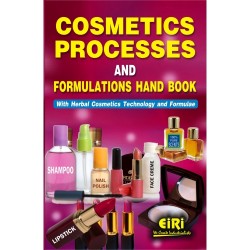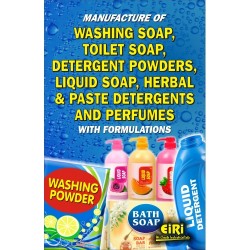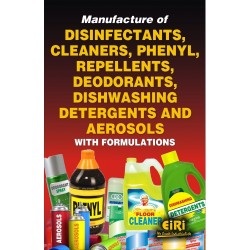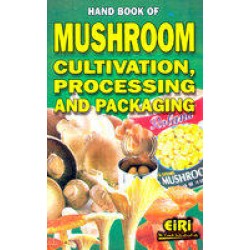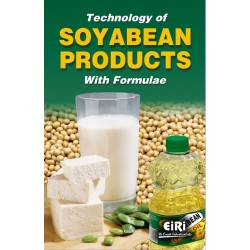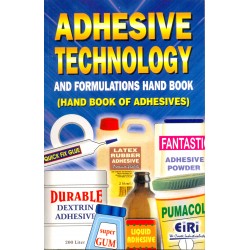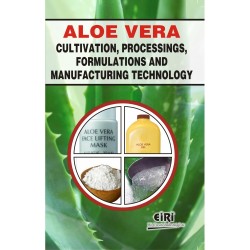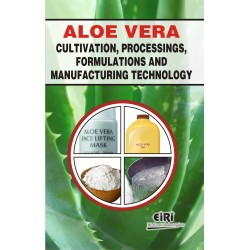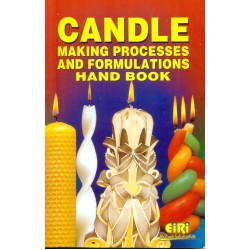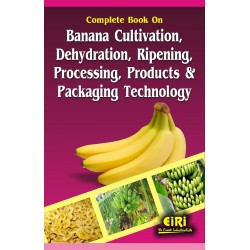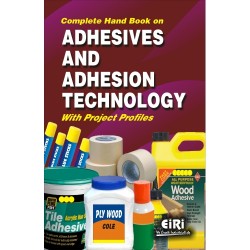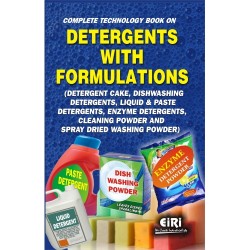hand book of perfumes with formulations
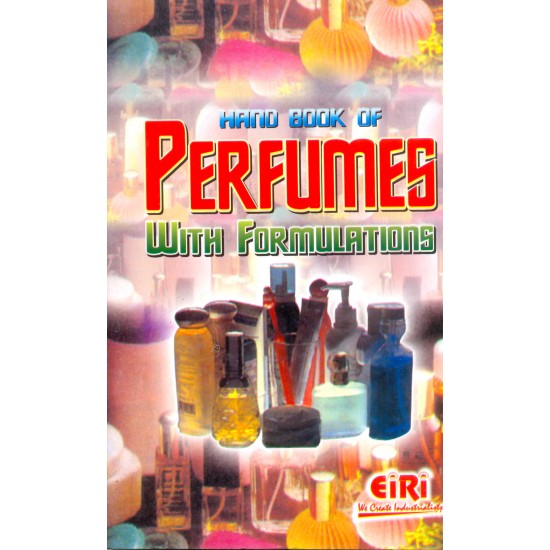
- More than 40 years of experience
- Managed by expert industrial consultants
- ISO 9001-2015 Certified
- Registered under MSME, UAM No: DL01E0012000
- 24/5 Research Support
Get your quesries resolved from an industry expert. Ask your queries before report or book purchase. - Custom Research Service
Speak to the our consultant to design an exclusive study to serve your research needs. - Quality Assurance
All reports are prepared by highly qualified consultants & verified by a panel of experts. - Information Security
Your personal & confidential information is safe & secure.
The book covers
Chap. I : Creating PERFUME :
1. Introduction
2. Working within a Framework
3. Price
4. Packaging
5. Inspiration
6. The Practical Foundation
7. Inspiration : Response to Stimuli
8. Trial and Error
9. Colours
10. Jeancard on Composition
11. Limitations of Formulae
12. The Perfumer's Knowledge of Chemistry
13. Creativity in the Art of Perfumery
14. Carles' Method
15. Merit of Carles' System
16. Tone
17. Volatility
18. Intensity
19. Volume
20. Atmosphere
21. Tenacity
22. Fixation
23. Systematic Recording of Data
Chap. II : FLOWER PERFUMES AND THEIR FORMULATION :
1. Introduction
2. Rose
3. Jasmine
4. Orange Flower and Neroli
5. Violet
6. Acacia
7. Broom
8. Carnation
9. Types of Carnation
10. Oeillet de Nice
11. Garden Pink
12. Sea Pink
13. Cyclamen
14. Fougere (Fern)
15. Gardenia
16. Hawthorn
17. Heliotrope
18. Honeysuckle
19. Hyacinth
20. Iris
21. Lilac
22. Lily-of-the-Valley
23. Linden (Lime Blossom)
24. Magnolia
25. Mignonetta (Reseda)
26. Mimosa
27. Narcissus
28. Nardo
29. New-Mown Hay
30. Nicotiana
31. Opopanax
32. Orchid (Orchidee)
33. Pansy
34. Peony
35. Phlox
36. Sweet Pea
37. Syringa (Philadephus)
38. Trefle (Clover)
39. Tuberose
40. Verbena
41. Wallflower
42. Wistaria
43. Ylang-Ylang
Chap. III : SOPHISTICATED/FANTASY PERFUMES AND THEIR FORMULATION :
1. Introduction
2. Aldehydic Perfumes
3. Chypre Types
4. Oriental Perfumes
5. Green' Perfumes
6. Dominant Note Types
7. The Ambergris Note
8. Manufacturing Processes
9. Alcoholic Strengths
10. Control
Chap. IV : COLOGNES : PERFUMES FOR Men :
1. Introduction
2. Toilet Waters
3. Grape Juice
4. Grain
5. Molasses
6. Synthesis
7. Modified Colognes
8. Perfumes for Men
9. Verbena
10. Violet
Chap. V : OLFACTION AND GUSTATION : THE Sense OF SMELL AND TASTE :
1. Introduction
2. Olfaction
3. Mechanism of Perception
4. Odourous and Odourless
5. What Makes a Substance Smell?
6. A Coding System for Olfactory Specificity
7. How/Does a Perfumer 'See' Odours
8. Abnormalities of Smell
9. Gustation
10. The Complexity of Flavour Perception
11. Taste-Sensitivity, Intuition and Introversion
Chap. VI : RAW MATERIALS OF PERFUMES (NATURAL ORIGIN) :
1. Introduction
2. Natural Odourants Employed in Perfumery
3. Concrete Oils
4. Absolute Oils
5. Essential Oils Derived Distillation
6. Essential Oils Obtained by Expression
7. Isolates from Essential Oils
8. Natural Odourants as Tinctures
9. Balsams and Resins
10. Concrete Oils or 'Concretes'
11. Absolute Oils
12. Floral Series
13. Rose Notes
14. Absolute Oil of Rose de Grasse
15. Bulgarian Rose Absolute
16. Moroccan and Turkish Rose Absolutes
17. Absolute of Rose Geranium
18. Absolute Oil of Rose Leaves
19. Jasmine Notes
20. Absolute Oil of Jasmine
21. Absolute of Ylang-Ylang
22. Hyacinth Notes
23. Lilac and Lily
24. Absolute Oil of Lilac
25. Lily-of-the-valley
26. Orange-blossom Notes
27. Orangeflower Absolute
28. Absolute Oil of Orangeflower Water
29. Absolute Oil of Syringa
30. Tuberose Notes
31. Absolute Oil of Tuberose
32. Absolute Oil of Narcissus
33. Absolute Oil of Jonquil
34. Absolute Oil of Champaca
35. Absolute Oil of Honeysuckle
36. Absolute Oil of Lily
37. Violet Notes
38. Absolute Oil of Violet
39. Absolute Oil of Parma Violet
40. Absolute Oil of Violet Leaves
41. Absolute Oil of Boronia
42. Absolute Oil of Cassie
43. Absolute Oil of Mimosa
44. Absolute Oil of Iris
45. Mignonette Notes
46. Absolute Oil of Mignonette (Reseda)
47. Woody Series
48. Sandal Notes
49. Solvent-extracted Sandalwood
50. Peppery Notes
51. Absolute Oil of Thyme
52. Caryophyllaceous Notes
53. Absolute Oil of Carnation
54. Absolute Oil of Clovers
55. Absolute Oil of Tobacco Flower
56. Rural Series
57. Herbaceous Notes
58. Absolute Oil of Flouve
59. New Mown Hazy Absolute
60. Absolute Oil of Lavender
61. Absolute Oil of Lavandin
62. Tea Leaf Absolute
63. Green Notes
64. Oakmoss (Mouse de Chene)
65. Absolute Oil of Fern
66. Absolute Oil of Ivy
67. Absolute Oil of Tree
68. Moss (Mousse d'Arbre)
69. Vetiver Absolute
70. Balsamic Series
71. Resinous Notes
72. Absolute Oil of Cypress
73. Absolute Oil of Fir Needles
74. Everlasting (Immortelle) Absolute
75. Vanilla Notes
76. Absolute Oil of Vanilla
77. Absolute Oil of Heliotrope
78. Fruity Series
79. Animal Series
80. Amber Notes
81. Ambrette Seed Absolute
82. Angelica Absolute
83. Cumin Absolute
84. Labdanum Absolute
85. Clary Sage Absolute
86. Maritime Notes
87. Seaweed Absolute
88. Musk Notes
89. Costus Absolute
90. Empyreumatic Series
91. Tobacco Notes
92. Mate (Pert) Absolute
93. Melilot Absolute
94. Tobacco Leaf Absolute
95. Essential Oils, Terpeneless Oils
96. Expressed Essential Oils
97. Bergamot
98. Grape Fruit
99. Lemon
100. Mandain
101. Orange
102. Orange, Sweet (Portugal)
103. Isolates, Esters etc.
104. Anise Oil
105. Bois de Rose Oil (Brazil)
106. Camomile Oil (German)
107. Cedarwood Oil (Virginian)
108. Citronella Oil (Java)
109. Clove Oil
110. Geranium Oil (Bourbon)
111. Lemongrass Oil
112. Palmarosa Oil
113. Sassafrass Oil
114. Tinctures, Resins, Balsams
115. Tinctures
116. Infusions
117. Absolutes
118. Ambergris
119. Castoreum
120. Civet
121. Musk
122. Ambrette Seed
123. Chaulmoogra
124. Orris
125. Vanilla Tincture
126. Balsams and Resins
127. Benzoin
128. Copaiba
129. Galbanum
130. Labdanum
131. Myrrh
132. Olibanum
133. Opopanax
134. Peru, Balsam
135. Styrax
136. Tolu Balsam
Chap. VII : RAW MATERIALS OF PERFUMES (SYNTHETIC ORIGIN) :
1. Introduction
2. Green Notes
3. Group A(1)
4. Methyl Heptin Carbonate (M.H.C.)
5. Methyl Octin Carbonate (M.O.C.)
6. Phenylacetaldehyde
7. Hydratropic Aldehyde
8. P-iso Propyl Phenylacetic Aldehyde
9. Group A(2)
10. Cis-3-Hexenal
11. Cis-3-Hexenol or 'Leaf Alcohol'
12. Cis-3-Hexenyl Acetate
13. Cis-3-Hexenyl Formate
14. Cis-3-Hexenyl Salicylate
15. Acetaldehyde-di-cis-3-hexenyl Acetal
16. Nonadienal
17. Nonadienal Diethyl Acetal
18. Dihydro-nor-dicyclopentadienly Acetate
19. Fruity Notes
20. Peach
21. Apricot
22. Plum
23. Mirabelle
24. Strawbeery
25. Raspberry
26. Blackcurrant
27. Fig
28. Hazel
29. Bitter Almond
30. Aniseed
31. Citrus Oils
32. Melon Notes
33. Angelica Oils
34. Woody Notes
35. Empyreumatic Notes
36. Animal Notes
37. Principal Odourants of Animal Origin
38. Musks, Synthetic
39. Civet, Synthetic
40. Ambergris, Synthetic
41. Chaulmoogra Oil
42. Castoreum Synthetic
43. Hexyl Benzoate (Woody-green-balsamic)
44. Citronellyl Ethoxylate (Sweet, Musky, Ambrette Odour)
45. The Salicylates
46. Iso Amyl Salicylate
47. Benzyl Salicylate
48. Isobutyl Salicylate
49. Methyl Salicylate
50. Ethyl Salicylate
51. Phenylethyl Salicylate
52. Acetates
53. Iso Amyl Acetate
54. Anisyl Acetate
55. Benzyl Acetate
56. Bornyl Acetate
57. Ibobutyl Acetate
58. Cedryl Acetate
59. Cinnamyl Acetate
60. Citronellyl Acetate
61. P-Cresyl Acetate
62. Dimethyl Benzyl Carbinyl Acetate
63. Dimethyl Octanyl Acetate (Tetrahydrogeranyl Acetate)
64. Dimethyl Phenyl Carbinyl Acetate
65. Ethyl Aceto-acetate
66. Ethyl Hexyl Carbinyl Acetate (3-nonanyl Acetate)
67. Ethyl Linalyl Acetate
68. Eugenyl Acetate
69. Geranyl Acetate
70. Linalyl Acetate
71. Epoxy Linalyl Acetate (Linalool Oxide Acetate)
72. Menthyl Acetate
73. P-Methoxy Phenylbutyl Acetate
74. Methyl Hexyl Carbinyl Acetate
75. Neryl Acetate
76. Octyl Acetate
77. Phenylethyl Acetate
78. Phenylpropyl Acetate (Hydrocinnamyl Acetate)
79. Rhodinyl Acetate
80. Santalyl Acetate
81. Terpinyl Acetate
82. Trichloromethyl Phenyl Carbinyl Acetate
83. The Fatty Alcohols, Aldehydes and Acetals
84. Acetophenone
85. Amyl Cinnamic Aldehyde
86. Anisic Alcohol
87. Anisic Aldehyde
88. Coumarin
89. P-Cresyl Amyl Ether
90. Dihydrocarveoi
91. Dihydromyrcenol
92. Dimethyl Benzyl Carbinol
93. Dimethyl Hydroquinone (Hydroquinone Dimethyl Ether)
94. Dimethyl Octanol (Tetrahydrogeraniol)
95. Dimethyl Phenyl Carbinol
96. Diphenyl Methane
97. Diphenyl Oxide
98. Estragole (Methyl Chavico!, Iso-anethole)
99. Ethyl-Hexyl Carbinol (3-nonanol) Ethyl Linalool
100. Ethyl Vanillin (Vanillal, Bourbonal)
101. Eugenol
102. Isoeugenol
103. Fixateur 404(Firmenich)
104. Geraniol
105. Heliotropin
106. Heptanal Glyceryl Acetal
107. Isohexenyl Tetrahydro Benzaldehyde
108. Hexylcinnamic Aldehyde
109. Hydroxycitronellal
110. Indole
111. Ionone Alpha
112. Ionone Beta
113. Isojasmone
114. Linalool
115. Menthone
116. Methyl Acetophenone
117. Methyl P-Cresol (Naracresol Methyl other)
118. Methyl Eugenol (Eugenol Methyl Ether)
119. Methyl Heptyl Ketone
120. Methyl Ionones
121. Methyl Methylanthranliate
122. Methyl Naphthyl Ketone
123. P-Methyl Quinolone
124. Muguet Aldehyde
125. Nerol
126. Nerolidol
127. Prienylacetic Acid
128. Phenylacetic Aldehyde
129. Phenylethyl Alcohol
130. Phenylpropyl Alcohol
131. Phenylpropyl Aldehyde (Hydrocinnamic Aldehyde)
132. Piperonyl Acetone (Hellotropyl Acetone)
133. Rhodinol
134. Safrole
135. Santalol
136. Skatole (Methyl Indole)
137. Terpineol
138. Teipmolene
139. P-Tolyl Acetaldehyde ('Syringa Aldehyde')
140. Trimethylcyclohexanone
141. Benzyl Valenanate (or Valerate)
142. Citronellyl Valerianate
143. Geranyl Valerianate
144. Linalyl Valerianate
145. Vanillin
Chap. VIII : CLASSIFICATION OF ODOURS AND ODOURANTS :
1. Introduction
2. Classification Based on Physical Characteristics :
Group-1 : Floral Series
Group-2 : Woody Series
Group-3 : Rustic Series
Group-4 : Balsamic Series
Group-5 : Fruity Series
Group 6 : Animal Series
Group 7 : Empyreumatic Series
Group 8 : Repulsive Series
Group 9 : Edible Series
Chap. IX. APPLICATIONS OF PERFUMES :
1. Introduction
2. Perfumes Used in Industrialised Society
3. Household Products
4. Personal Products
5. Agricultural Products
6. Flavours
7. Perfumes for Soaps
8. Factors Influencing Soap Perfuming
9. Esters
10. Alcohols
11. Ketones
12. Aldehydes and Acetals
13. Other Constituents
14. Soap Perfumery Fashions
15. Perfuming Synthetic Detergents
16. Stability of Perfumery Chemicals
17. Perfumed Disinfectants
18. Perfuming the Air
19. Incense and Fumigants
20. Pefumed Candles
21. Paints and Polishes
22. Other Household Products
23. Perfuming Cosmetics
24. Adapting the Perfume to the Vehicle
25. Perfuming Creams
26. Perfuming Powders
27. Perfuming Lipstick and Nail Lacquer!
28. Hair Preparation Perfumes
29. Perfumed Aerosols
30. Pharmacy and Medicine
31. Industrial Perfumes
32. Perfumes for Textiles
33. Perfumed Ink and Paper
34. Masking Malodours
35. Perfume in Agriculture
36. Perfumed Insecticides
37. Miscellaneous Uses
38. Flavours as Perfumes
Chap. X : PACKAGING OF PERFUMES :
1. Introduction
2. Packaging in the Past
3. The Impact of Aerosols
4. Perfume Identity
5. The Name
6. The Bottle
7. Labels
8. Cartons and Coffrets
9. External Wrapping
10. Perfume and the World of Fashion
11. The Question of Colour
12. The Means of Advertising
13. Press Publicity
14. Sampls and Models
Chap. XI : TESTING OF PERFUMES :
1. Introduction
2. Sampling
3. Closed Type (Undivided)
4. Closed Type (Divided)
5. Open Type Sampling Scoop
6. Sampling from Tanks
7. Criteria for Conformity
8. For Individual Samples
9. Examples
10. Packing and Labelling
11. Instructions Regarding Costly Materials
12. Analysis
13. Preparation of the Material for Physico-chemical Analysis
14. Physical Analysis
15. Estimation of Relative Density
16. Estimation of Relative Density by Pyknometer
17. Principle
18. Apparatus
19. Procedure
20. Calculation
21. Determination of Freezing Point
22. Principle
23. Apparatus
24. Procedure
25. Results
26. Determination of Refractive Index by Refractometer
27. Principle
28. Apparatus
29. Refractometer, Light Source (Sodium Light)
30. Procedure'
31. Calculation
32. Determination of Solubility in Ethanol
33. Principle
34. Apparatus
35. Reagents
36. Procedure
37. Calculations
38. Determination of Optical Rotation and Specific Rotation by Polarlmeter
39. Principle
40. Apparatus
41. Procedure
42. Calculation
43. Determination of Melting Point and Melting Range
44. Principle
45. Apparatus
46. Procedure
47. Results
48. Determination of Boiling (Distillation) Range
49. Principle
50. Apparatus
51. Procedure
52. Method for Olfactory Assessment of Natural and Synthetic Perfumery Materials
53. Principle
54. Terminology
55. Material Requirements
56. Ethyl alcohol, Perfumery Grade
57. Diethyl Phthalate, Perfumery Grade
58. Determination of Resideu on Evaporation
59. Apparatus
60. Procedure
61. Calculation
62. Chemical Analysis
63. Determination of Content of Alcohol Insoluble Solid Impurities
64. Principle
65. Procedure
66. Calculation
66. Determination of Water Content
67. Principle
68. Reagent
69. Apparatus
70. Calculation
71. Determination of Acid Value
72. Principle
73. Apparatus
74. Reagents
75. Procedure
76. Determination of Ester Value, Content of Estaers and Combined Alcohols
77. Principle
78. Apparatus
79. Reagents
80. Prepared Sample
81. Procedure
82. Calculation
83. Determination of Ester Value after Acetylation and free Alcohols
84. Apparatus
85. Reagents
86. Procedure
87. Calculation
88. Principle
89. Apparatus
90. Reagents
91. Procedure
92. Calculation
93. Determination of Carbonyl Value and Content of Carbonyl Compounds
94. Hydroxylammonium Chloride Method - Method - A
95. Principle
96. Apparatus
97. Reagents
98. Procedure
99. Calculation
100. Principle
101. Apparatus
102. Reagents
103. Procedure
104. Calculation
105. Determination of Phenols
106. Principle
107. Apparatus
108. Reagents
109. Procedure
110. Determination
111. Calculation
112. Determination of Heavy Metals
113. Determination of Lead Content
114. Apparatus
115. Procedure
116. Reagent Blank Determination
117. Expression of Results
118. Determination of Iron
119. Reagents
120. Standard Iron Solution
121. Procedure
122. Detection of Petroleum and Mineral Oils
123. Apparatus
124. Reagents
125. Estimation of Chlorine
126. Principle
127. Apparatus
128. Procedure
129. Result
130. Determination of Cineole Content
131. Principle
132. Apparatus
133. Reagents
134. Procedure
135. Calculation
Chap. XII : Aerosol Spray :
1. Manufacturing Process
2. Essence and Perfumery
3. General Procedure
4. Synthetic Rose Otto No. 1056
5. Red Roses No.-1057
6. Violet No. 1068
7. Plant Economics
8. Plant & Machinery
9. Fixed Capital
10. Raw Materials
11. Total Working Capital/Month
12. Total Capital Investment
13. Turn Over/Annum
Chap. XIII : Aromatic PERFUMERY COMPOUNDS :
1. Formulation and Raw Materials
2. Fancy Bougnet
3. Manufacturing Process
4. Fancy Bouquet
5. Process
6. Royale Bouquet
7. Process
8. Plant Economics
9. Plant & Machinery
10. Fixed Capital
11. Raw Materials
12. Total Working Capital/Annum
13. Total Capital Investment
14. Turn Over/Annum
Chap. XIV : SCENTS AND PERFUMES :
1. Process of Manufacture
2. Extraction Process
3. Extraction Volatile Solvent
4. Plant Economics
5. Plant & Machinery
6. Fixed Capital
7. Raw Materials
8. Total Working Capital/Month
9. Total Capital Investment
10. Turn Over/Annum
Chap. XV : SPRAY (PERFUME) :
1. Manufacturing Process
2. Essence and Perfumery
3. General Procedure
4. Synthetic Rose Otto No. 1056
5. Red Roses no. 1057
6. Violet No. 1068
7. Plant Economics
8. Plant & Machinery
9. Fixed Capital
10. Raw Materials
11. Total Working Capital/Month
12. Total Capital Investment
13. Turn Over/Annum
Chap. XVI : PERFUMES FOR SOAP, DETERGENT AND Agarbatti ETC. YARA YARA :
1. Process of Manufacture
2. Plant Economics
3. Plant & Machinery
4. Fixed Capital
5. Raw Materials
6. Total Working Capital/Month
7. Total Capital Investment
8. Turn Over/Annum
Chap. XVII : PERFUMERY COMPOUNDS :
1. Rose Concrete
2. Rose Absolute
3. Process of Manufacture
4. Water Distillation
5. Water and Steam Distillation
6. Steam Distillation
Chap. XVIII : INTIMATE SCENT, CHEMICALS ETC. FROM ALL TYPES OF Flowers :
1. Manufacturing Process
Chap. XIX : SUPPLIERS OF Plants EQUIPMENTS :
1. Refrigeration Unit
2. Distilling Machine
3. Boilers Industrial
4. Blenders
5. Aerosol Filling Machine
6. Storage Tanks
7. Lab Equipments
Chap. XX : SUPPLIERS OF PACKAGING MATERIALS :
1. Packaging
2. Aerosol Cans
3. Glass Bottles
4. Caps (Aluminium)
Chap. XXI : SUPPLIERS OF RAW MATERIALS :
1. Essential Oil
2. Aromatic Solvents
3. Perfume Musk
4. Flavouring
Chap. XXII : PRESENT MANUFACTURERS/SUPPLIERS/EXPORTERS
Engineers India Research Institute (EIRI) is a renowned name in the industrial world for offering technical and financial consultancy services.
EIRI services are:
- Detailed Feasibility Reports
- New Project Identification
- Project Feasibility and Market Study
- Identification of Lucrative Industrial Project Opportunities
- Preparation of Project Profiles / Pre-Investment and Detailed Feasibility Studies,
- Market Surveys / Studies, Market Survey Cum Detailed Techno-Economic Feasibility Reports
- Project Reports in CD Roms
- Identification of Plant /Process/Machinery and Equipment, Industrial General Guidance for setting up new industrial projects.
- Our most up-to-date and Technologically Advanced Industrial Project Reports, categorized with respect to Financial Outlays and Sector – wise Classification are immensely useful for :
Existing Small or Medium Scale Industrialists facing competition from large houses
Young Entrepreneurs dreaming to start their own industrial enterprise
Young Graduates and Professionals wishing to begin their career
Industrialists interested in Debottlenecking their capacities & New Product – Lines
Large Industrial Houses pursuing Expansion, Growth and Diversification Plans
Latest Books
How to Make Project Report?
Detailed Project Report (DPR) includes Present Market Position and Expected Future Demand, Technology, Manufacturing Process, Investment Opportunity, Plant Economics and Project Financials. comprehensive analysis from industry covering detailed reporting and evaluates the position of the industry by providing insights to the SWOT analysis of the industry.
Each report include Plant Capacity, requirement of Land & Building, Plant & Machinery, Flow Sheet Diagram, Raw Materials detail with suppliers list, Total Capital Investment along with detailed calculation on Rate of Return, Break-Even Analysis and Profitability Analysis. The report also provides a birds eye view of the global industry with details on projected market size and then progresses to evaluate the industry in detail.
We can prepare detailed project report on any industry as per your requirement.
We can also modify the project capacity and project cost as per your requirement. If you are planning to start a business, contact us today.
Detailed Project Report (DPR) gives you access to decisive data such as:
- Market growth drivers
- Factors limiting market growth
- Current market trends
- Market structure
- Key highlights
Overview of key market forces propelling and restraining market growth:
- Up-to-date analyses of market trends and technological improvements
- Pin-point analyses of market competition dynamics to offer you a competitive edge major competitors
- An array of graphics, BEP analysis of major industry segments
- Detailed analyses of industry trends
- A well-defined technological growth with an impact-analysis
- A clear understanding of the competitive landscape and key product segments
Need Customized Project Report?
- Ask for FREE project related details with our consultant/industry expert.
- Share your specific research requirements for customized project report.
- Request for due diligence and consumer centric studies.
- Still haven't found what you're looking for? Speak to our Custom Research Team
About Engineers India Research Institute:
Note: We can also prepare project report on any subject based on your requirement and country. If you need, we can modify the project capacity and project cost based on your requirement.
Our Clients

Our Approach
- Our research reports comprehensively cover Indian markets (can be modified as per your country), present investigation, standpoint and gauge for a time of five years*.
- The market conjectures are produced on the premise of optional research and are cross-accepted through associations with the business players
- We use dependable wellsprings of data and databases. What's more, data from such sources is handled by us and incorporated into the report
Why buy EIRI reports?
- Our project reports include detailed analysis that help to get industry Present Market Position and Expected Future Demand.
- Offer real analysis driving variables for the business and most recent business sector patterns in the business
- This report comprehends the present status of the business by clarifying a complete SWOT examination and investigation of the interest supply circumstance
- Report gives investigation and top to bottom money related correlation of real players/competitors
- The report gives gauges of key parameters which foresees the business execution





















